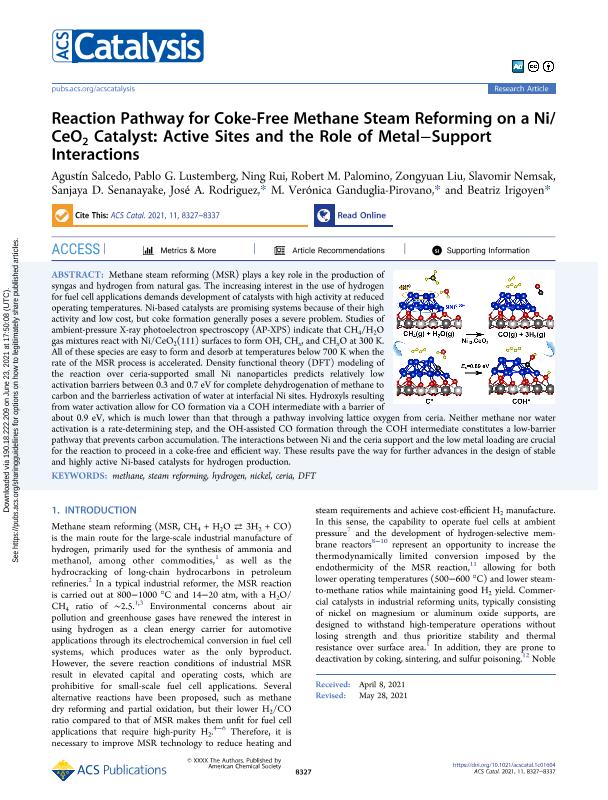Artículo
Reaction Pathway for Coke-free methane steam reforming on a Ni/ CeO2Catalyst: Active Sites and the Role of Metal-Support Interactions
Salcedo, Agustín ; Lustemberg, Pablo German
; Lustemberg, Pablo German ; Rui, Ning; Palomino, Robert M.; Liu, Zongyuan; Nemsak, Slavomir; Senanayake, Sanjaya D.; Rodriguez, José A.; Ganduglia Pirovano, M. Verónica; Irigoyen, Beatriz del Luján
; Rui, Ning; Palomino, Robert M.; Liu, Zongyuan; Nemsak, Slavomir; Senanayake, Sanjaya D.; Rodriguez, José A.; Ganduglia Pirovano, M. Verónica; Irigoyen, Beatriz del Luján
 ; Lustemberg, Pablo German
; Lustemberg, Pablo German ; Rui, Ning; Palomino, Robert M.; Liu, Zongyuan; Nemsak, Slavomir; Senanayake, Sanjaya D.; Rodriguez, José A.; Ganduglia Pirovano, M. Verónica; Irigoyen, Beatriz del Luján
; Rui, Ning; Palomino, Robert M.; Liu, Zongyuan; Nemsak, Slavomir; Senanayake, Sanjaya D.; Rodriguez, José A.; Ganduglia Pirovano, M. Verónica; Irigoyen, Beatriz del Luján
Fecha de publicación:
06/2021
Editorial:
American Chemical Society
Revista:
ACS Catalysis
ISSN:
2155-5435
Idioma:
Inglés
Tipo de recurso:
Artículo publicado
Clasificación temática:
Resumen
Methane steam reforming (MSR) plays a key role in the production of syngas and hydrogen from natural gas. The increasing interest in the use of hydrogen for fuel cell applications demands development of catalysts with high activity at reduced operating temperatures. Ni-based catalysts are promising systems because of their high activity and low cost, but coke formation generally poses a severe problem. Studies of ambient-pressure X-ray photoelectron spectroscopy (AP-XPS) indicate that CH4/H2O gas mixtures react with Ni/CeO2(111) surfaces to form OH, CHx, and CHxO at 300 K. All of these species are easy to form and desorb at temperatures below 700 K when the rate of the MSR process is accelerated. Density functional theory (DFT) modeling of the reaction over ceria-supported small Ni nanoparticles predicts relatively low activation barriers between 0.3 and 0.7 eV for complete dehydrogenation of methane to carbon and the barrierless activation of water at interfacial Ni sites. Hydroxyls resulting from water activation allow for CO formation via a COH intermediate with a barrier of about 0.9 eV, which is much lower than that through a pathway involving lattice oxygen from ceria. Neither methane nor water activation is a rate-determining step, and the OH-assisted CO formation through the COH intermediate constitutes a low-barrier pathway that prevents carbon accumulation. The interactions between Ni and the ceria support and the low metal loading are crucial for the reaction to proceed in a coke-free and efficient way. These results pave the way for further advances in the design of stable and highly active Ni-based catalysts for hydrogen production.
Palabras clave:
CERIA
,
DFT
,
HYDROGEN
,
METHANE
,
NICKEL
,
STEAM REFORMING
Archivos asociados
Licencia
Identificadores
Colecciones
Articulos(IFIR)
Articulos de INST.DE FISICA DE ROSARIO (I)
Articulos de INST.DE FISICA DE ROSARIO (I)
Articulos(ITHES)
Articulos de INST. DE TECNOLOGIAS DEL HIDROGENO Y ENERGIAS SOSTENIBLES
Articulos de INST. DE TECNOLOGIAS DEL HIDROGENO Y ENERGIAS SOSTENIBLES
Citación
Salcedo, Agustín; Lustemberg, Pablo German; Rui, Ning; Palomino, Robert M.; Liu, Zongyuan; et al.; Reaction Pathway for Coke-free methane steam reforming on a Ni/ CeO2Catalyst: Active Sites and the Role of Metal-Support Interactions; American Chemical Society; ACS Catalysis; 11; 13; 6-2021; 8327-8337
Compartir
Altmétricas



